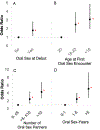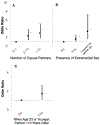Timing, number, and type of sexual partners associated with risk of oropharyngeal cancer
- PMID: 33426652
- PMCID: PMC8035131
- DOI: 10.1002/cncr.33346
Timing, number, and type of sexual partners associated with risk of oropharyngeal cancer
Abstract
Background: Case-control studies from the early 2000s demonstrated that human papillomavirus-related oropharyngeal cancer (HPV-OPC) is a distinct entity associated with number of oral sex partners. Using contemporary data, we investigated novel risk factors (sexual debut behaviors, exposure intensity, and relationship dynamics) and serological markers on odds of HPV-OPC.
Methods: HPV-OPC patients and frequency-matched controls were enrolled in a multicenter study from 2013 to 2018. Participants completed a behavioral survey. Characteristics were compared using a chi-square test for categorical variables and a t test for continuous variables. Adjusted odds ratios (aOR) were calculated using logistic regression.
Results: A total of 163 HPV-OPC patients and 345 controls were included. Lifetime number of oral sex partners was associated with significantly increased odds of HPV-OPC (>10 partners: odds ratio [OR], 4.3 [95% CI, 2.8-6.7]). After adjustment for number of oral sex partners and smoking, younger age at first oral sex (<18 vs >20 years: aOR, 1.8 [95% CI, 1.1-3.2]) and oral sex intensity (>5 sex-years: aOR, 2.8 [95% CI, 1.1-7.5]) remained associated with significantly increased odds of HPV-OPC. Type of sexual partner such as older partners when a case was younger (OR, 1.7 [95% CI, 1.1-2.6]) or having a partner who had extramarital sex (OR, 1.6 [95% CI, 1.1-2.4]) was associated with HPV-OPC. Seropositivity for antibodies to HPV16 E6 (OR, 286 [95% CI, 122-670]) and any HPV16 E protein (E1, E2, E6, E7; OR, 163 [95% CI, 70-378]) was associated with increased odds of HPV-OPC.
Conclusion: Number of oral sex partners remains a strong risk factor for HPV-OPC; however, timing and intensity of oral sex are novel independent risk factors. These behaviors suggest additional nuances of how and why some individuals develop HPV-OPC.
Keywords: head and neck cancer; oropharyngeal neoplasms; papillomaviridae; risk factors; sexual behavior.
© 2021 American Cancer Society.
Conflict of interest statement
Figures


Similar articles
-
Distinct biomarker and behavioral profiles of human papillomavirus-related oropharynx cancer patients by age.Oral Oncol. 2020 Feb;101:104522. doi: 10.1016/j.oraloncology.2019.104522. Epub 2019 Dec 24. Oral Oncol. 2020. PMID: 31881446 Free PMC article.
-
Case-control study of human papillomavirus and oropharyngeal cancer.N Engl J Med. 2007 May 10;356(19):1944-56. doi: 10.1056/NEJMoa065497. N Engl J Med. 2007. PMID: 17494927
-
Characterization of human papillomavirus (HPV) 16 E6 seropositive individuals without HPV-associated malignancies after 10 years of follow-up in the UK Biobank.EBioMedicine. 2020 Dec;62:103123. doi: 10.1016/j.ebiom.2020.103123. Epub 2020 Nov 25. EBioMedicine. 2020. PMID: 33248371 Free PMC article.
-
Sexual history of patients with human papillomavirus positive and negative oropharyngeal cancer: A systematic review and meta-analysis.Head Neck. 2024 Oct;46(10):2473-2483. doi: 10.1002/hed.27733. Epub 2024 Mar 13. Head Neck. 2024. PMID: 38477218
-
National prevalence of oral HPV infection and related risk factors in the U.S. adult population.Oral Dis. 2012 Jul;18(5):430-41. doi: 10.1111/j.1601-0825.2011.01892.x. Epub 2012 Jan 18. Oral Dis. 2012. PMID: 22251072 Review.
Cited by
-
Etiology, diagnosis, treatment, and prevention of human papilloma virus-associated oropharyngeal squamous cell carcinoma.Int J Clin Oncol. 2023 Aug;28(8):975-981. doi: 10.1007/s10147-023-02336-8. Epub 2023 Apr 24. Int J Clin Oncol. 2023. PMID: 37093464 Free PMC article. Review.
-
Sexual Behavior and Perceived Risk for Oropharyngeal Cancer Among Men Who Have Sex With Men: A Psychometric Scale Validation.Sex Transm Dis. 2024 Apr 1;51(4):289-294. doi: 10.1097/OLQ.0000000000001923. Epub 2024 Jan 10. Sex Transm Dis. 2024. PMID: 38430512 Free PMC article.
-
HPV and Cervical Cancer-Biology, Prevention, and Treatment Updates.Curr Oncol. 2025 Feb 22;32(3):122. doi: 10.3390/curroncol32030122. Curr Oncol. 2025. PMID: 40136326 Free PMC article. Review.
-
Impact of HPV vaccination on HPV-related oral infections.Oral Oncol. 2023 Jan;136:106244. doi: 10.1016/j.oraloncology.2022.106244. Epub 2022 Nov 16. Oral Oncol. 2023. PMID: 36402055 Free PMC article.
-
Heterosexual Oral and Anal Sex: Perceptions, Terminologies, and Attitudes of Younger and Older Adults in Ibadan, Nigeria.Arch Sex Behav. 2023 Jan;52(1):161-175. doi: 10.1007/s10508-022-02313-8. Epub 2022 Sep 19. Arch Sex Behav. 2023. PMID: 36123563 Free PMC article.
References
Publication types
MeSH terms
Substances
Grants and funding
LinkOut - more resources
Full Text Sources
Other Literature Sources

